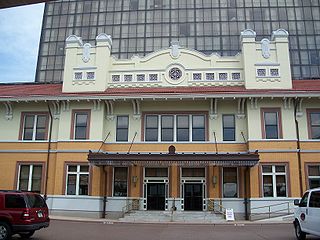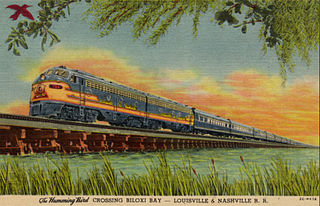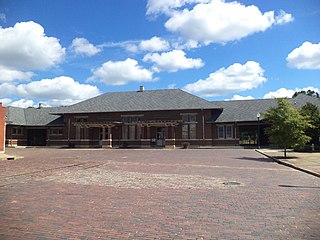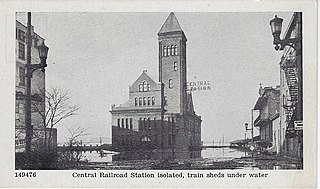
Dearborn Station was, beginning in the late 1800s, one of six intercity train stations serving downtown Chicago, Illinois. It remained in operation until May 1, 1971. Built in 1883, it is located at Dearborn and Polk Streets, to the south of the Loop, adjacent to Printers Row. The station was owned by the Chicago & Western Indiana Railroad, which itself was owned by the companies operating over its line. The station building headhouse now houses office, retail, and entertainment spaces, and its trackage yard, behind the headhouse, was redeveloped into part of the Dearborn Park neighborhood.

The Louisville and Nashville Railroad, commonly called the L&N, was a Class I railroad that operated freight and passenger services in the southeast United States.

The Floridian was a train operated by Amtrak from 1971 to 1979 that ran between Chicago and Florida, with two branches south of Jacksonville terminating at Miami and St. Petersburg. For its Nashville to Montgomery segment, its route followed that of several former Louisville & Nashville Railroad (L&N) passenger trains, including the Pan-American and the Humming Bird. Originating in Chicago, the train served Lafayette and Bloomington, Indiana; Louisville and Bowling Green, Kentucky; Nashville, Tennessee; Decatur, Birmingham, Montgomery and Dothan, Alabama; and Thomasville, Valdosta and Waycross, Georgia.

The Chicago and Eastern Illinois Railroad was a Class I railroad that linked Chicago to southern Illinois, St. Louis, and Evansville. Founded in 1877, it grew aggressively and stayed relatively strong throughout the Great Depression and two World Wars before finally being purchased by the Missouri Pacific Railroad and the Louisville and Nashville Railroad (L&N). Missouri Pacific merged with the C&EI corporate entity in 1976, and was later acquired itself by the Union Pacific Railroad.

The Union Station of Louisville, Kentucky is a historic railroad station that serves as offices for the Transit Authority of River City (TARC), as it has since mid-April 1980 after receiving a year-long restoration costing approximately $2 million. It was one of at least five union stations in Kentucky, amongst others located in Lexington, Covington, Paducah and Owensboro. It was one of three stations serving Louisville, the others being Central Station and Southern Railway Station. It superseded previous, smaller, railroad depots located in Louisville, most notably one located at Tenth and Maple in 1868–1869, and another L&N station built in 1858. The station was formally opened on September 7, 1891, by the Louisville and Nashville Railroad. There was a claim made at the time that it was the largest railroad station in the Southern United States, covering forty acres. The other major station in Louisville was Central Station, serving the Baltimore and Ohio, the Illinois Central and other railroads.

The Louisville and Nashville Passenger Station and Express Building is a historic Louisville and Nashville Railroad passenger train depot in Pensacola, Florida.

The Union Station built in 1930 in Atlanta was the smaller of two principal train stations in downtown, Terminal Station being the other. It was the third "union station" or "union depot", succeeding the 1853 station, burned in mid-November 1864 when Federal forces left Atlanta for the March to the Sea, and the 1871 station.

The Humming Bird was a named train of the Louisville and Nashville Railroad (L&N). The train, inaugurated in 1946, originally ran from Cincinnati, Ohio, to New Orleans, Louisiana, via Louisville, Nashville, Birmingham, Montgomery and Mobile and later via a connection at Bowling Green, Kentucky, to Memphis, Tennessee. A connection to Chicago was provided by the Chicago and Eastern Illinois Railroad.
The Louisville and Nashville Depot, or Louisville and Nashville Railroad Depot or Louisville and Nashville Passenger Station, Louisville and Nashville Railroad Passenger Depot or variations, may refer to the following former and active train stations previously used by the Louisville and Nashville Railroad. Some of these are listed on the National Register of Historic Places (NRHP).
The South Wind was a named passenger train equipped and operated jointly by the Pennsylvania Railroad, the Louisville and Nashville Railroad, the Atlantic Coast Line Railroad, and the Florida East Coast Railway. The South Wind began operations in December 1940, providing streamliner service between Chicago, Illinois and Miami, Florida. This was one of three new seven-car, all-coach streamliners operating in coordination every third day along different routes between Chicago and Miami. The other two longest enduring Chicago-Florida trains were the City of Miami and the Dixie Flagler. The South Wind remained in service through the creation of Amtrak in 1971.

The Union Station in Owensboro, Kentucky, is a historic railroad station, built in 1905. Built mostly for the Louisville and Nashville Railroad, the station is made of limestone and slate, and currently is home to several businesses.

The Dixie Flagler was a streamlined passenger train operated by the Florida East Coast Railway (FEC) between Chicago, Illinois and Miami, Florida. It began in 1939 as the Henry M. Flagler, a regional service between Miami and Jacksonville, Florida; the FEC renamed it and extended it to Chicago a year later. It was one of the few Chicago to Florida trains that passed through Atlanta. As an overnight streamliner it was part of the every-third-day pool shared by the City of Miami and South Wind. It was renamed Dixieland in 1954 and discontinued altogether in 1957.

Albany Railroad Depot Historic District is located at the 100 block of West Roosevelt Avenue in Albany, Georgia, United States, and is governed by the Thronateeska Heritage Center, a 501(c)3 not-for-profit organization incorporated in 1974 for the purpose of historic preservation and science education in Southwest Georgia. The Heritage Plaza includes the Tift Warehouse, the Union Station depot, the Railway Express Agency building and Albany's last remaining brick street and is listed in the National Register of Historic Places (NRHP).

The Western and Atlantic Depot is a historic Western and Atlantic Railroad train depot in Dalton, Georgia. It was built in 1852 in the Greek Revival style. The building is the oldest surviving commercial structure in Dalton and is a "fine example" of depot architecture in Georgia in the mid-1800s. It served as both a freight and passenger station.

The Dixie Flyer was a premier named passenger train that operated from 1892 to 1965 via the "Dixie Route" from Chicago and St. Louis via Evansville, Nashville, and Atlanta to Florida. However, the train continued until 1969 as an Atlanta to Florida operation, run solely by the Atlantic Coast Line Railroad and its successor, the Seaboard Coast Line. The Flyer's route varied in early years, but by about 1920 was set as follows:
Chattanooga Union Station, more commonly known as the Union Depot in Chattanooga, constructed between 1857 and 1859, served as a train car shed in Chattanooga, Tennessee. Located at Broad and Ninth Streets, the station was one of two major railroad terminals in the city, the other being the Southern Railway's Terminal Station.
The Georgian was a long-distance passenger train operated by the Louisville and Nashville Railroad in conjunction with the Chicago and Eastern Illinois Railroad. It operated between St. Louis Union Station and Atlanta's Union Station with a section operated by the C&EI from Evansville to Chicago's Dearborn Station. From Nashville to Atlanta it operated over the tracks of the Nashville, Chattanooga and St. Louis Railway. The introduction of this train made the C&EI's Chicago-Evansville Whippoorwill train superfluous.

Central Station was a major train station in Louisville, Kentucky. Built in the Richardsonian Romanesque style, it served several railroad companies until the mid-20th century. It was situated at North 7th Street and West River Road, near the Ohio River waterfront, and it was also known as the 7th Street Depot.
The Marietta depot is a former freight and passenger stop in Marietta, Georgia. It was originally built in 1864 for the Western and Atlantic Railroad, a railroad between Chattanooga, Tennessee and Atlanta, Georgia. That railroad was absorbed by the Nashville, Chattanooga and St. Louis Railway. In turn, the latter railroad was merged into the Louisville and Nashville Railroad in 1957.

Columbus Union Station was a union station in Columbus, Georgia. The building was built in 1901 and was designed in the Second Empire style by the architectural firm, Bruce and Morgan. The station hosted the Central Railroad of Georgia, the Seaboard Air Line Railroad and the Southern Railway. It was located at 1200 Sixth Avenue, directly north of 12th Street, Columbus.



















